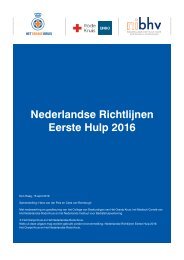Thesis-Anne-Vos-Masters-SBR-and-EU-Law-3
Thesis-Anne-Vos-Masters-SBR-and-EU-Law-3
Thesis-Anne-Vos-Masters-SBR-and-EU-Law-3
You also want an ePaper? Increase the reach of your titles
YUMPU automatically turns print PDFs into web optimized ePapers that Google loves.
practice this distinction is less visible. In practice, the prevention principle is almost always called<br />
upon in combination with the precautionary principle. Not only in case law, but also in policy<br />
documents are references to the prevention principle often 'forgotten', since it is deemed that the<br />
precautionary principle already includes this principle. 376 This could question the independent<br />
meaning of the prevention principle (towards the precautionary principle) <strong>and</strong> this discussion is<br />
also visible in literature. 377 It is even stated in literature that the principles should be used<br />
synonymously, since they are always invoked together <strong>and</strong> no separate definition appears from the<br />
Treaties. 378<br />
In some cases the Court itself also seems to 'blur the lines' between the two principles, e.g. in<br />
some cases concerning the BSE-decease she considered that although there was still scientific<br />
uncertainty, action should have been taken on the basis of the prevention principle. 379 Here,<br />
recourse to the precautionary principle was more logical to clarify the difference between the two<br />
principles. More in general, the Court applies the prevention principle sporadic. The CJ<strong>EU</strong> more<br />
often applies the (above mentioned) Directives that have the principle as its underlying objective.<br />
Examples are the Directive 96/82/EC on the control of major-accident hazards involving dangerous<br />
substances, 380 the Industrial Emission Directive, 381 etc. The use of the prevention principle by the<br />
CJ<strong>EU</strong> is remarkable with regard to the interpretation of the concept of waste in the Waste<br />
Framework Directive. Here, the Court has consistently decided that the term ‘discard’ must be<br />
interpreted in the light not only of the essential objective of Directive 75/442, but also of Article<br />
191(2) TF<strong>EU</strong>, whereby the concept of 'waste' cannot be interpreted restrictively. 382 However, both<br />
principles are mentioned in Art. 191(2), whereby not only the prevention principle, but also the<br />
precautionary principle has influenced this line of reasoning.<br />
All in all, the principles are still<br />
distinguished in Article 191(2) TF<strong>EU</strong><br />
(<strong>and</strong> other legislation) <strong>and</strong> sometimes<br />
by the CJ<strong>EU</strong>. Therefore, this distinction<br />
will be maintained hereinafter. The<br />
included table clarifies the distinction<br />
between those principles. 383<br />
Finally, a short comment could be made on the similarity between the prevention principle <strong>and</strong> the<br />
principle that environmental damage should as a priority be rectified at source, which can also be<br />
found in Article 191(2) TF<strong>EU</strong>. Here again, prevention is better than cure. However, the rectification<br />
at the source-principle only comes into play when the prevention principle is not applicable<br />
376<br />
Backes et al. (2002), p. 83.<br />
377<br />
Fennis (2012), p. 48, where she refers to Trouwborst (2007); Drupsteen (2000); <strong>and</strong> Jesse (2008).<br />
378<br />
See e.g. Krämer (2011), p. 24.<br />
379<br />
Case C-157/96 The Queen <strong>and</strong> Ministry of Agriculture, Fisheries <strong>and</strong> Food [1998] ECR I-02211, paragraph 64 <strong>and</strong><br />
further; <strong>and</strong> Case C-180/96 UK <strong>and</strong> Northern Irel<strong>and</strong> v Commission [1998] ECR I-02265, paragraph 100 <strong>and</strong> further.<br />
380<br />
Case C-53/10 L<strong>and</strong> Hessen v Franz Mücksch [2011] ECR I-08311.<br />
381<br />
Case C-117/02 Commission v Portugal [2004] ECR I-05517.<br />
382<br />
See e.g. Case C113/12 Donal Brady v Environmental Protection Agency [2013] not yet published, paragraph 39; Case<br />
C188/07 Commune de Mesquer [2008] ECR I4501, paragraphs 38-39; Case C252/05 Thames Water Utilities [2007]<br />
ECR I3883, paragraph 27; Case C194/05 Commission v Italy, paragraph 33; Joined Cases C418/97 <strong>and</strong> C419/97<br />
ARCO Chemie Nederl<strong>and</strong> <strong>and</strong> Others [2000] ECR I4475, paragraphs 39-40; <strong>and</strong> Joined Cases C-175/98 <strong>and</strong> C-177/98<br />
Lirussi <strong>and</strong> Bizzaro [1999] ECR I-6881.<br />
383<br />
Source table: http://ec.europa.eu/environment/legal/law/pdf/principles/9%20Preventive%20<strong>and</strong>%20Precautionary%20<br />
Principles_revised.pdf<br />
74



